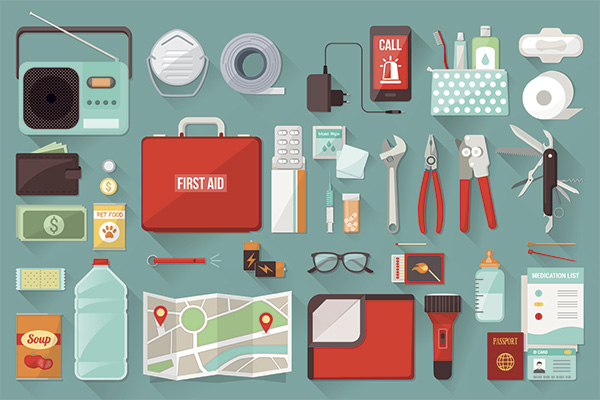This is part 4 of a 4-part article. (Read part 1 - part 2 - part 3)
Previously, we’ve discussed what a bug out bag is, how to choose one, and how to pack it. In this final part, we’ll cover the most critical aspect: What to put in your bug out bag!
Your bug out bag, or 72-hour kit, should include items tailored to your family’s needs and local environment. For example, a desert dweller may need more water storage instead of a filter. Here’s a list of essential items to consider:
Essential Food Items
- Calorie Bars: Compact and packed with energy. Look for 3600-calorie bars, which are affordable and have a shelf life of up to 5 years.
- MREs (Meals Ready to Eat): Convenient meals, some with self-heating options. Storage location affects their shelf life.
- Freeze-Dried Pouches: Lightweight and durable, with a shelf life of up to 30 years. Store in cool areas to preserve longevity.
- Plant Guides: A plant guide for local vegetation can help identify edible plants in an emergency.
- Hunting Gear: Include tools like snares, bows, or firearms for long-term survival needs.

Cooking and Food Preparation
- Knives: A versatile tool for food preparation, hunting, and other tasks. Look for hunting knives with additional saw blades.
- Pots and Pans: Lightweight cooking tools, perfect for emergencies. Consider portable stoves like a “Stove in a Can.”
- Fire Starters: Include matches, lighters, magnesium starters, or road flares to ensure fire-building capabilities.
Water Supplies
- Water Containers: Durable, leak-proof containers for water storage.
- Water Filters: Ideal for areas with access to rivers or lakes.
- Water Purifiers: Add purification tablets or drops to ensure water safety.
First-Aid Kit
A well-prepared first-aid kit can save lives. Refer to our previous post for tips on building a comprehensive first-aid kit.
Light and Communication Tools
- Whistle: Essential for attracting attention from long distances.
- Crank Flashlight: A battery-free flashlight is reliable in emergencies.
- Emergency Radios: Choose crank or solar-powered radios for receiving updates.
- Walkie Talkies: Set these to a specific channel for family communication.
Warmth and Clothing
- Extra Clothes: Pack a durable set of clothing, including pants and shirts.
- Gloves: Protect your hands during physical tasks.
- Hats: Bring a cap or beanie for sun protection or heat retention.
- Emergency Blankets: Lightweight, compact blankets that provide warmth.
Navigation Tools
- Compass: Lightweight and reliable navigation aid.
- Maps: Include detailed maps of your local and surrounding areas.
- GPS: Advanced tools for tracking and navigation; ideal for family preparedness.

Personal and Identification Items
- Medical Records: Carry a list of prescriptions and allergies.
- Identification: Include copies of your identification documents.
Hygiene and Cosmetic Supplies
Include travel-sized hygiene items like:
- Toothpaste and toothbrush
- Soap
- Extra glasses
Additional Tools and Items
- Fold-Up Shovel: Useful for digging fire pits or waste disposal.
- Cord: Compact, lightweight alternative to rope.
- Gas Mask: Optional but useful in specific emergencies.
- Hunters’ Vest: Bright colors improve visibility in emergencies.
- Binoculars: Helpful for navigation and hunting.
- Screwdriver: Essential for repairs on tools or devices.
Conclusion
Thank you for reading our 4-part series on bug out bags. We hope this guide helps you prepare effectively for emergencies. Stay safe and ready!












